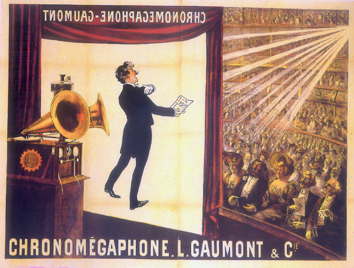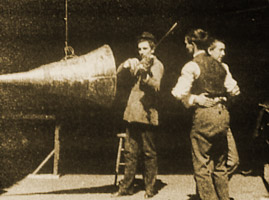|
Compressed Air Gramophone
Compressed air gramophones were gramophones which employed compressed air and a pneumatic amplifier to amplify the recorded sound. One of the earliest versions was the , designed by the Anglo-Irish engineer Sir Charles Parsons. It was capable of producing sufficient volume to broadcast public music performances from the top of the Blackpool Tower, and was said to be loud enough to cause people to vacate the front rows of seats in an auditorium.http://www.douglas-self.com/MUSEUM/COMMS/auxetophone/auxetoph.htm "The Auxetophone & Other Compressed-Air Gramophones" Retrieved 19 June 2012 The Auxetophone was sold in the United States as the Victor Auxetophone. Pneumatic Amplifier A was realised by using a sensitive valve, which required little force to operate, to modulate the flow of a stream of compressed air. The basic principle of the valves used in these devices was to pass the stream of compressed air through two partially overlapping combs. The sound vibrations to be amplifie ... [...More Info...] [...Related Items...] OR: [Wikipedia] [Google] [Baidu] |
Phonograph
A phonograph, in its later forms also called a gramophone (as a trademark since 1887, as a generic name in the UK since 1910) or since the 1940s called a record player, or more recently a turntable, is a device for the mechanical and analogue recording and reproduction of sound. The sound vibration waveforms are recorded as corresponding physical deviations of a spiral groove engraved, etched, incised, or impressed into the surface of a rotating cylinder or disc, called a "record". To recreate the sound, the surface is similarly rotated while a playback stylus traces the groove and is therefore vibrated by it, very faintly reproducing the recorded sound. In early acoustic phonographs, the stylus vibrated a diaphragm which produced sound waves which were coupled to the open air through a flaring horn, or directly to the listener's ears through stethoscope-type earphones. The phonograph was invented in 1877 by Thomas Edison. Alexander Graham Bell's Volta Laboratory made s ... [...More Info...] [...Related Items...] OR: [Wikipedia] [Google] [Baidu] |
Compressed Air
Compressed air is air kept under a pressure that is greater than atmospheric pressure. Compressed air is an important medium for transfer of energy in industrial processes, and is used for power tools such as air hammers, drills, wrenches, and others, as well as to atomize paint, to operate air cylinders for automation, and can also be used to propel vehicles. Brakes applied by compressed air made large railway trains safer and more efficient to operate. Compressed air brakes are also found on large highway vehicles. Compressed air is used as a breathing gas by underwater divers. It may be carried by the diver in a high pressure diving cylinder, or supplied from the surface at lower pressure through an air line or diver's umbilical. Similar arrangements are used in breathing apparatus used by firefighters, mine rescue workers and industrial workers in hazardous atmospheres. In Europe, 10 percent of all industrial electricity consumption is to produce compressed air—amountin ... [...More Info...] [...Related Items...] OR: [Wikipedia] [Google] [Baidu] |
Charles Algernon Parsons
Sir Charles Algernon Parsons, (13 June 1854 – 11 February 1931) was an Anglo-Irish engineer, best known for his invention of the compound steam turbine, and as the eponym of C. A. Parsons and Company. He worked as an engineer on dynamo and turbine design, and power generation, with great influence on the naval and electrical engineering fields. He also developed optical equipment for searchlights and telescopes. Career and commercial activity Parsons was born into an Anglo-Irish family in London as the youngest son of the famous astronomer William Parsons, 3rd Earl of Rosse. (The family seat is Birr Castle, County Offaly, Ireland, and the town of Birr was called Parsonstown, after the family, from 1620 to 1901.) With his three brothers, Parsons was educated at home in Ireland by private tutors (including John Purser), all of whom were well versed in the sciences and also acted as practical assistants to the Earl in his astronomical work. (One of them later bec ... [...More Info...] [...Related Items...] OR: [Wikipedia] [Google] [Baidu] |
Blackpool Tower
Blackpool Tower is a tourist attraction in Blackpool, Lancashire, England, which was opened to the public on 14 May 1894. When it opened, Blackpool Tower was the List of tallest buildings in the British Empire and the Commonwealth, tallest man made structure in the British Empire. Inspired by the Eiffel Tower in Paris, it is tall and is the 125th-tallest freestanding tower in the world. Blackpool Tower is also the common name for the Tower Buildings, an entertainment complex in a red-brick three-storey block that comprises the tower, Tower Circus, the Tower Ballroom, and roof gardens, which was designated a Listed building, Grade I listed building in 1973. Background The Blackpool Tower Company was founded by London-based Standard Contract & Debenture Corporation in 1890; it bought an aquarium on Central Promenade with the intention of building a replica Eiffel Tower on the site. John Bickerstaffe, a former mayor of Blackpool, was asked to become chairman of the new company, and ... [...More Info...] [...Related Items...] OR: [Wikipedia] [Google] [Baidu] |
Gaumont Film Company
The Gaumont Film Company (, ), often shortened to Gaumont, is a French film studio headquartered in Neuilly-sur-Seine, France. Founded by the engineer-turned-inventor Léon Gaumont (1864–1946) in 1895, it is the oldest extant film company in the world, established before other studios such as Pathé (founded in 1896), Titanus (1904), Nordisk Film (1906), Universal, Paramount, and Nikkatsu (founded in 1912). Gaumont predominantly produces, co-produces, and distributes films, and in 2011, 95% of Gaumont's consolidated revenues came from the film division. The company is increasingly becoming a TV series producer with its American subsidiary Gaumont International Television as well as its existing French production features. Gaumont is run by Nicolas Seydoux (President), Sidonie Dumas (General Director), and Christophe Riandee (Deputy General Director). History Originally dealing in photographic apparatus, the company began producing short films in 1897 to promote its make of ... [...More Info...] [...Related Items...] OR: [Wikipedia] [Google] [Baidu] |
Sound Film
A sound film is a motion picture with synchronized sound, or sound technologically coupled to image, as opposed to a silent film. The first known public exhibition of projected sound films took place in Paris in 1900, but decades passed before sound motion pictures became commercially practical. Reliable synchronization was difficult to achieve with the early sound-on-disc systems, and amplification and recording quality were also inadequate. Innovations in sound-on-film led to the first commercial screening of short motion pictures using the technology, which took place in 1923. The primary steps in the commercialization of sound cinema were taken in the mid-to-late 1920s. At first, the sound films which included synchronized dialogue, known as "talking pictures", or "talkies", were exclusively shorts. The earliest feature-length movies with recorded sound included only music and effects. The first feature film originally presented as a talkie (although it had only limited so ... [...More Info...] [...Related Items...] OR: [Wikipedia] [Google] [Baidu] |
Audio Players
Audio most commonly refers to sound, as it is transmitted in signal form. It may also refer to: Sound *Audio signal, an electrical representation of sound *Audio frequency, a frequency in the audio spectrum *Digital audio, representation of sound in a form processed and/or stored by computers or digital electronics *Audio, audible content (media) in audio production and publishing *Semantic audio, extraction of symbols or meaning from audio *Stereophonic audio, method of sound reproduction that creates an illusion of multi-directional audible perspective *Audio equipment Entertainment *AUDIO (group), an American R&B band of 5 brothers formerly known as TNT Boyz and as B5 * ''Audio'' (album), an album by the Blue Man Group * ''Audio'' (magazine), a magazine published from 1947 to 2000 *Audio (musician), British drum and bass artist * "Audio" (song), a song by LSD Computing *, an HTML element, see HTML5 audio See also *Acoustic (other) *Audible (other) *Audio ... [...More Info...] [...Related Items...] OR: [Wikipedia] [Google] [Baidu] |
Mechanical Amplifiers
Mechanical may refer to: Machine * Machine (mechanical), a system of mechanisms that shape the actuator input to achieve a specific application of output forces and movement * Mechanical calculator, a device used to perform the basic operations of arithmetic * Mechanical energy, the sum of potential energy and kinetic energy * Mechanical system, a system that manages the power of forces and movements to accomplish a task * Mechanism (engineering), a portion of a mechanical device Other * Mechanical (character), one of several characters in Shakespeare's ''A Midsummer Night's Dream'' * A kind of typeface in the VOX-ATypI classification See also * Machine, especially in opposition to an electronic item * ''Mechanical Animals'', the third full-length studio release by Marilyn Manson * Manufactured or artificial, especially in opposition to a biological or natural component * Automation, using machine decisions and processing instead of human * Mechanization, using machine labor inste ... [...More Info...] [...Related Items...] OR: [Wikipedia] [Google] [Baidu] |





